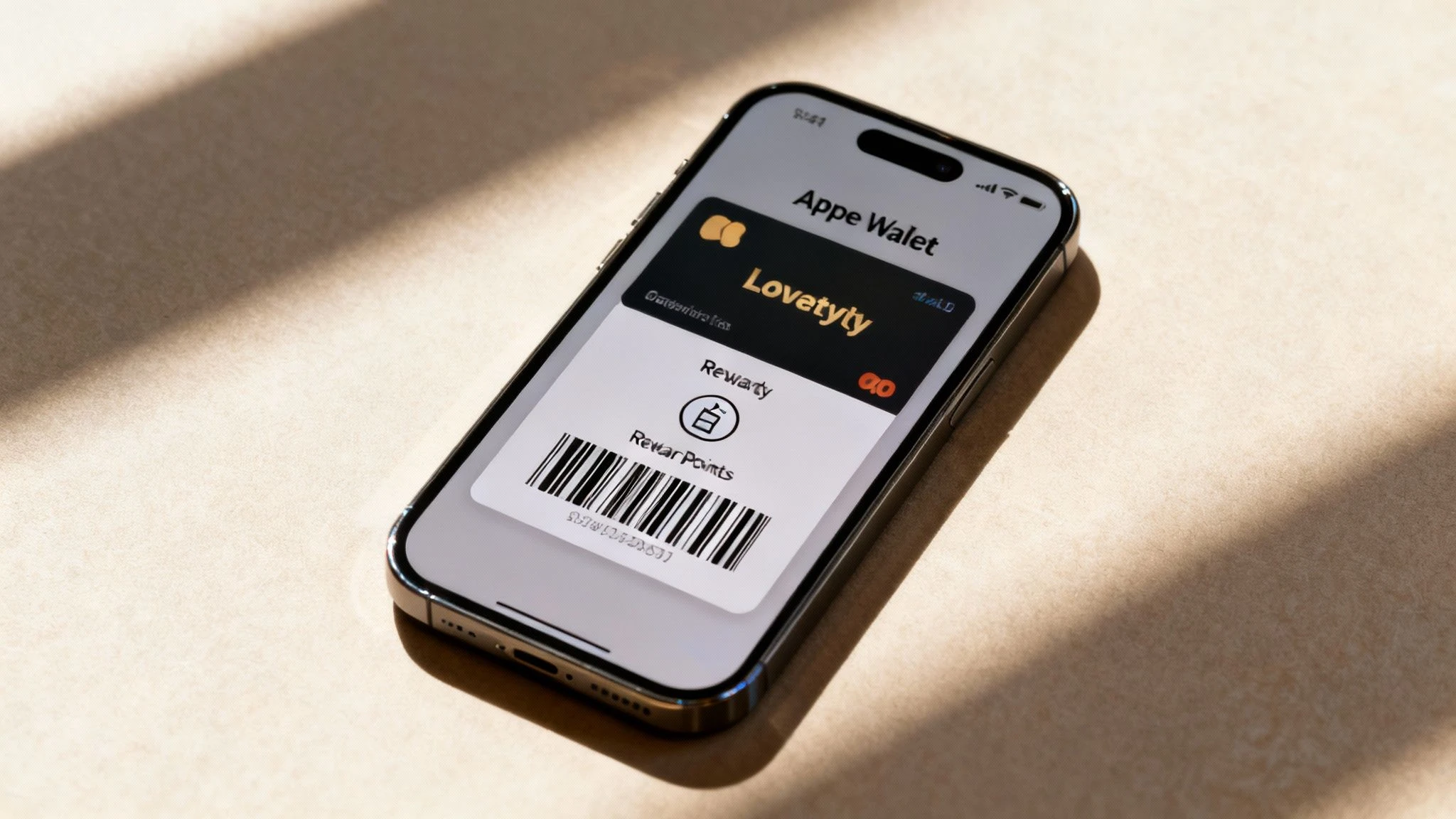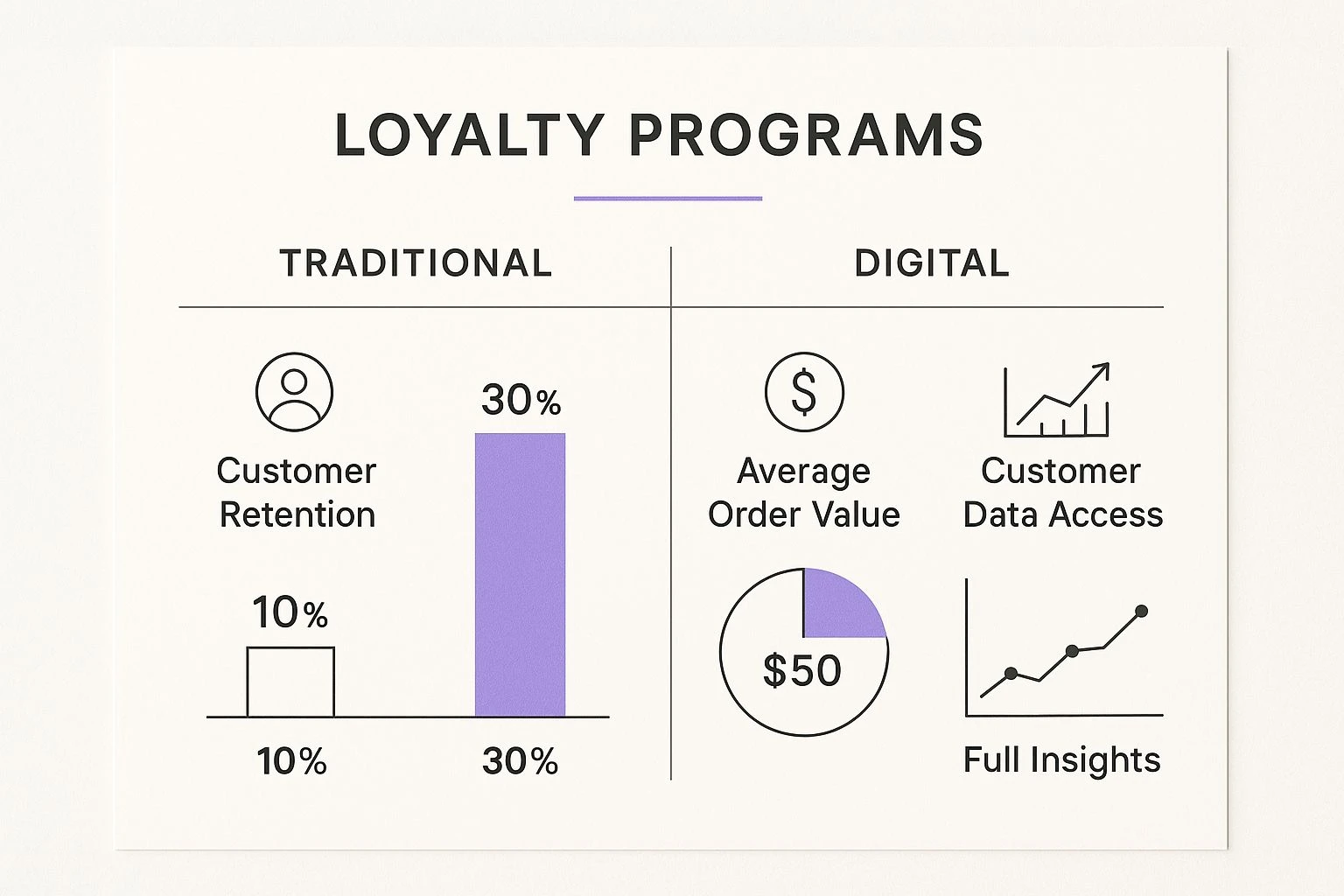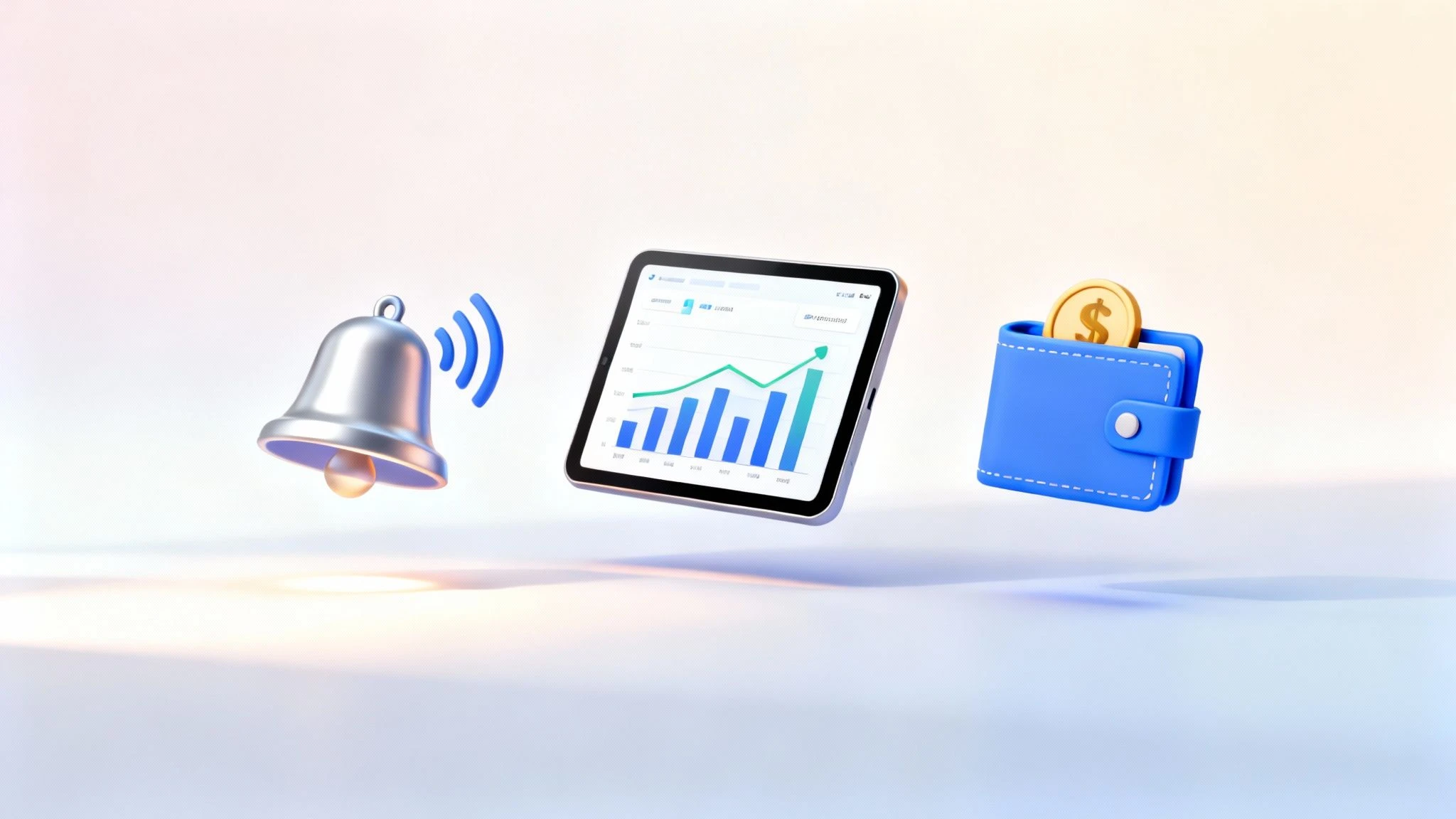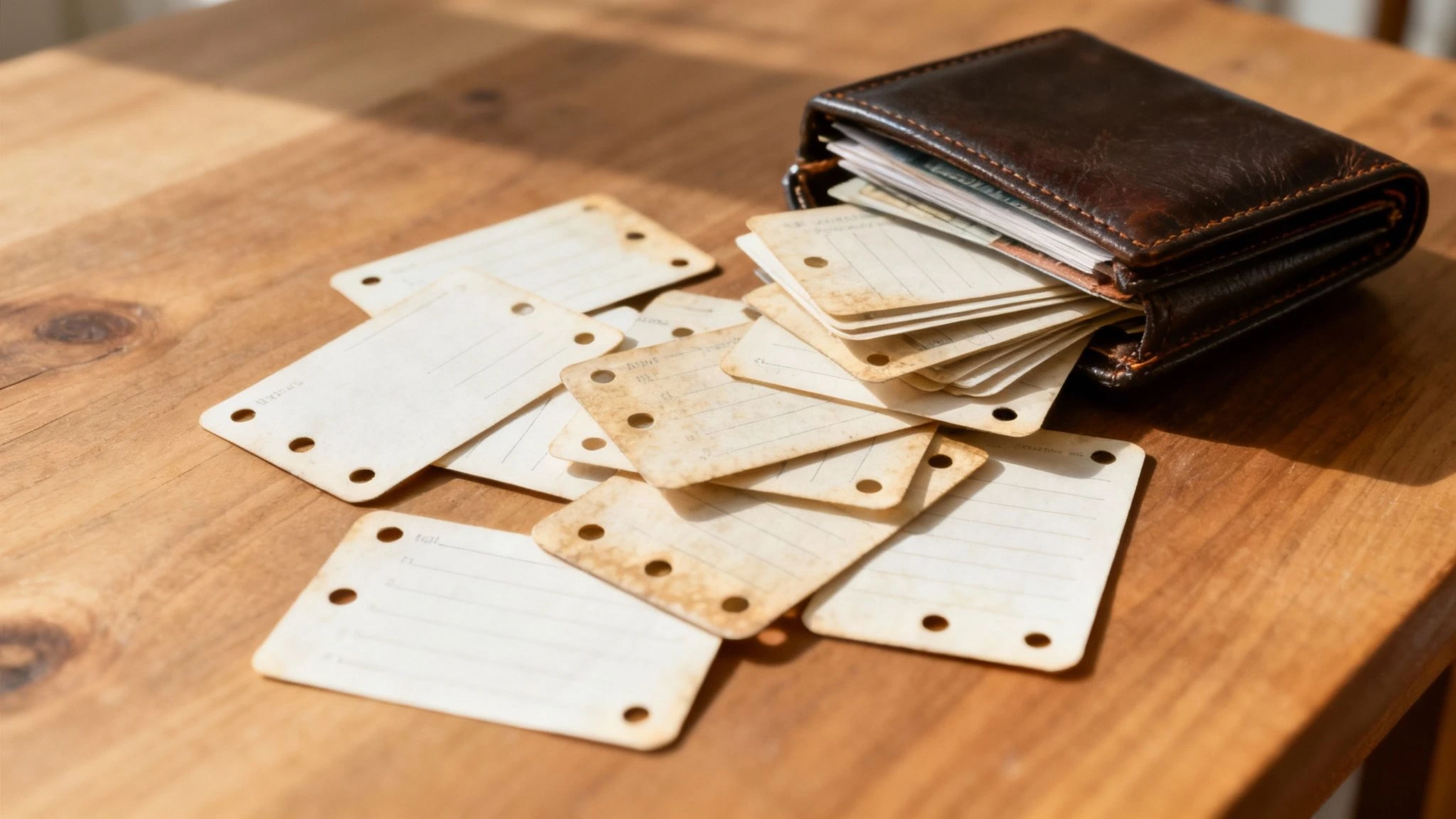Remember that stack of flimsy paper cards crammed into your wallet? The ones that get lost, crumpled, or accidentally thrown out with an old receipt. For decades, that was the gold standard for loyalty, but let's be honest-it’s a broken system for everyone involved.
Why Paper Punch Cards Just Don’t Cut It Anymore
The traditional punch card is a relic. For customers, it’s a pain. Forgetting your card means you miss out on a reward you’ve earned, and that feels bad. It’s frustrating to know you’re owed a free coffee but can’t claim it because the card is sitting on your kitchen counter.
But the bigger problem is what’s happening on your side of the counter. Paper cards are a black box. You give them out, but you get absolutely nothing back in return.
A paper punch card tells you that someone made a purchase. It tells you nothing about who they are, what they bought, or how often they come back. You can't build a real relationship with a customer you don't know.
This is the fundamental flaw of the old-school system. It runs on guesswork. You might recognize a familiar face, but you have no real way to identify and reward the people who are truly keeping your business alive.
The Data Blind Spot
Without data, you're flying blind. You have no way to answer critical questions that could transform your business, like:
- Who are my top 10% of customers?
- Which of my regulars haven’t I seen in the last month?
- What’s the average time between visits for my loyal fans?
This massive information gap is exactly what digital loyalty cards for business were designed to fix. They don’t just replace the paper; they replace the guesswork with real, actionable insights.
By moving from a physical card to a digital one, you turn a simple transaction into a meaningful interaction. You can learn more about how a digital version of a classic loyalty program stamp card creates these opportunities. This shift isn't just an upgrade-it's a necessary evolution for any business serious about building genuine, lasting customer relationships.
What Are Digital Loyalty Cards

Remember those old-school paper punch cards? The ones you’d inevitably lose or forget right when you were about to earn a free coffee. Now, imagine that same simple idea, but smarter, faster, and living right inside your customer's smartphone. That’s a digital loyalty card.
It's a slick, modern system that ditches the flimsy paper and replaces it with a smart pass stored in your customer’s Apple Wallet or Google Pay. There's no separate app to download, which means no friction, no forgotten cards, and no holding up the line at checkout.
This simple shift does something powerful: it turns a basic transaction into a meaningful, data-rich interaction. Instead of just punching a hole, the system tracks purchases, logs visits, and updates a customer's progress toward their next reward in real-time. It just works.
More Than Just a Digital Stamp
At its heart, a digital loyalty card is a direct line to your best customers. It’s not just about swapping paper for pixels; it’s a whole new way to build relationships and truly understand what makes your regulars tick.
When a customer scans a simple QR code to join your program, you start to see their habits in a way that was never possible with a paper card.
A digital loyalty card moves you from guessing who your best customers are to knowing for certain. It connects a name and a purchase history to every transaction, turning anonymous visitors into engaged fans of your brand.
This connection lets you craft a more personal and compelling experience. You can see who comes in most often, what they love to buy, and even get a heads-up when a regular hasn't stopped by in a while.
The Technology Behind the Simplicity
The world is catching on fast. Digital loyalty programs are no longer a novelty; they’re becoming powerful tools for businesses of all sizes. The market is projected to skyrocket to an estimated $150 billion by 2033, all because businesses and customers want more seamless, personalized mobile experiences. You can dive deeper into the trends with these insights on the digital loyalty market growth on datainsightsmarket.com.
The tech that makes this all feel so simple is focused on a few key things:
- Wallet Integration: Cards are stored right in Apple Wallet or Google Pay. They’re always accessible and dead simple to use.
- Automated Tracking: Every visit or purchase automatically updates the customer's points or stamps. No manual work needed.
- Direct Communication: You can send targeted push notifications with offers and updates directly to a customer's lock screen. It’s like having a billboard in their pocket.
This is what makes digital loyalty cards for business such a game-changer. It gives you a rock-solid, user-friendly foundation to build a rewards program that people actually love to use-one that brings them back again and again.
Real Benefits For Your Business
Let's be honest, those flimsy paper punch cards have had their day. Moving to a digital loyalty card isn't just a minor upgrade; it's about transforming a simple giveaway into a powerhouse for business growth. The results are tangible, hitting your bottom line where it counts, starting with keeping your customers around.
When you make it dead simple for people to earn and track rewards right on their phones, you eliminate all the usual friction. No more lost cards or forgotten punches. You just keep them engaged and, more importantly, keep them coming back. The convenience of a card that lives in their phone's wallet means they always have it, nudging them to visit just a little more often. This isn't just about making people happy-it's about building profitable habits.
This infographic paints a pretty clear picture of the performance gap between old-school punch cards and modern digital loyalty programs.

As you can see, making the switch can dramatically lift key business metrics, from how many customers you keep to how much each one spends.
Unlock Powerful Customer Insights
This might be the biggest game-changer of all: for the first time, you get access to incredibly valuable customer data. Paper cards are a black hole-they tell you nothing. Digital programs, on the other hand, tell you everything.
Imagine knowing exactly who your top 10% of customers are, what they buy most often, and when they last visited. This is the kind of insight that used to be reserved for massive corporations.
With a digital loyalty program, you can finally answer the questions that matter:
- Who are my VIPs? Pinpoint your most loyal fans and surprise them with exclusive perks.
- Who is at risk of leaving? See which regulars haven't stopped by recently and send a targeted "we miss you" offer to win them back.
- What promotions actually work? You can test different offers and see in real-time which ones are driving the most sales.
This data-driven approach lets you make smarter marketing moves and create a more personal experience. It's a direct line to fostering long-term relationships and is a key strategy for improving customer lifetime value.
Before we dig deeper into the other benefits, let's quickly compare the old and the new.
Traditional vs Digital Loyalty Cards A Quick Comparison
It's one thing to talk about benefits, but seeing a side-by-side comparison really drives the point home. Here’s a quick breakdown of how traditional paper cards stack up against their modern digital counterparts.
| Feature | Traditional Punch Cards | Digital Loyalty Cards |
|---|---|---|
| Customer Convenience | Easily lost or forgotten. Bulky in a wallet. | Always on their phone. Zero physical clutter. |
| Data Collection | None. Completely anonymous. | Rich data on visit frequency, spend, and preferences. |
| Personalization | One-size-fits-all offers. No targeting. | Highly personalized rewards and targeted messages. |
| Communication | No direct way to communicate with customers. | Send push notifications for offers and reminders. |
| Brand Image | Can feel outdated or cheap. | Modern, tech-savvy, and professional. |
| Cost & Environment | Ongoing printing costs. Creates paper waste. | Lower long-term costs. Eco-friendly. |
As the table shows, digital isn't just a different format-it's a fundamentally smarter, more powerful tool for building loyalty.
Increase Spending and Enhance Your Brand
Digital programs are also wired to get customers to spend more. You can send strategic push notifications to announce a new product or run a "double points day" to pack the house during a slow afternoon. This kind of proactive engagement encourages customers to add that one extra item to their cart or visit when they otherwise might not have.
The numbers don't lie. By 2025, it's expected that members of loyalty programs will spend, on average, 3.8 times more with the brands they love. It’s no wonder 63% of U.S. business leaders are pumping more money into these initiatives. Just look at giants like Starbucks, which credits its loyalty members for a revenue boost of around 40%.
Finally, offering a slick, modern experience just makes your brand look good. It signals that you value your customers' time and are in step with today's world. This helps you stand out, compete with the big chains, and create a sophisticated, memorable experience that people will talk about.
Essential Features Of A Great Loyalty Program

Choosing a digital loyalty platform is a bit like picking the perfect tool for a critical job-the features you select will make or break your success. The truth is, not all digital loyalty cards for business are built the same. A great program has to be dead simple for customers to use and incredibly powerful for you to manage.
Think of it as a checklist. Before you sign on the dotted line, you need to be sure the platform ticks the right boxes to drive repeat visits, boost sales, and deliver the insights you need to grow. The best systems remove all the friction for the customer while handing you actionable data on a silver platter.
Seamless Wallet Integration
If there's one feature that’s an absolute must-have, it's native wallet integration. This means your digital loyalty card lives right inside a customer’s Apple Wallet or Google Pay. Why is this a non-negotiable? It demolishes the single biggest barrier to getting people on board: making them download yet another app.
When a customer can add your card with a quick QR code scan and pull it up from their phone's lock screen, they are infinitely more likely to actually use it. This app-free approach makes the whole experience feel smooth and intuitive, not like a clunky add-on.
Automated Rewards And Push Notifications
Your loyalty program should work for you, not create more work. Look for a system that handles rewards automatically. When a customer earns their free coffee or discount, that reward should pop up instantly without you or your staff lifting a finger. This guarantees a consistent, error-free experience every single time.
On top of that, the ability to send targeted push notifications is a total game-changer. These are the short, punchy messages that appear right on a customer's lock screen.
A push notification is your direct line to your best customers. It's the modern equivalent of a personal invitation, allowing you to announce a flash sale, promote a new product, or send a 'we miss you' offer to bring back a lapsed regular.
This single feature turns your loyalty program from a passive reward system into an active, on-demand marketing channel.
Robust Analytics and Segmentation
How can you possibly reward your best customers if you have no idea who they are? A powerful analytics dashboard is your mission control. It’s where you transform raw transaction data into smart, profitable business decisions. Without it, you’re flying blind.
A great platform should give you clear, easy-to-digest insights on:
- Visit Frequency: See exactly how often your most loyal customers are stopping by.
- Average Spend: Track how much your members are spending compared to everyone else.
- Customer Segmentation: Automatically sort customers into helpful groups like "New," "Loyal," and "At-Risk."
This is the data that fuels smart, targeted marketing. For example, you can spot your VIPs and send them an exclusive offer as a thank-you, or nudge your at-risk customers with a special incentive to win them back. To see this in action, you can learn more about the power of loyalty program analytics and stats and how they drive smarter decisions. This is the engine that powers a truly effective loyalty strategy.
How To Launch Your Digital Loyalty Program
Making the switch to a digital loyalty program is one of the smartest moves a small business can make right now. The global market for customer loyalty is exploding, valued at $15.19 billion in 2025 and expected to more than double to a staggering $41.21 billion by 2032.
With 90% of companies already running some kind of loyalty program and 65% planning upgrades, staying on the sidelines isn't an option. If you want to see more stats on this trend, queue-it.com has a great breakdown.
But launching a program doesn't have to feel like a massive, complicated project. When you break it down into a few clear stages, you can build something your customers-and your bank account-will absolutely love. Let's walk through the roadmap.
Step 1: Define Your Primary Goal
Before you even think about rewards or software, stop and ask yourself one simple question: What am I actually trying to achieve here?
A loyalty program without a clear goal is like a ship without a rudder. It might look nice, but it's not going anywhere useful. Your core objective will steer every decision you make, from the rewards you pick to the platform you choose.
Get specific and make it measurable. "More customers" is a wish, not a goal.
- Want more frequent visits? "I want my average customer to visit 20% more often."
- Need to boost spending? "My goal is to increase the average order value by $5."
- Trying to win back old customers? "I want to reactivate 15% of customers who haven't stopped by in 90 days."
When you have a clear target, you have a benchmark for success. It's the only way to know if your program is actually delivering a return on your investment.
Step 2: Choose An Exciting Reward Structure
Your rewards are the heart and soul of your program. They need to be simple enough for a customer to understand in five seconds and valuable enough to get them genuinely excited.
A system that's too complex will just confuse people. A boring reward won't motivate anyone to change their habits.
Here are a few popular structures for digital loyalty cards for business that just plain work:
- Points-Based System: This is the classic model where customers earn points for every dollar spent (e.g., 10 points per dollar). It's fantastic for encouraging slightly larger purchases.
- Tiered Program: As customers spend more, they unlock better perks and climb the ranks. This creates a powerful sense of status and exclusivity, perfect for building long-term brand fans.
- Cashback or Credit: This one is direct and to the point. Offering something like "5% back on all purchases" is a powerful hook for budget-conscious shoppers who appreciate instant value.
The trick is to offer something your customers will actually care about.
Step 3: Design A Frictionless Signup And Launch
Okay, you've picked your platform and decided on your rewards. Now it's time to get people on board. The signup process has to be ridiculously easy-think a single QR code scan at the checkout counter.
Every extra step you add is a reason for someone to say, "I'll do it later." The fewer steps, the more people will actually sign up.
Finally, you need a strong launch to build momentum from day one. Get your team excited about it so they can explain the benefits in a few seconds. Plaster it on your social media, put up signs in your store, and send an email to your list.
Offering an immediate sign-up bonus is the single most effective way to kickstart your program. A free item or a significant discount on their next purchase provides instant gratification and makes joining a no-brainer.
A well-planned launch sets the stage for long-term success. If you're looking for more ideas, check out our guide on creating a winning loyalty program onboarding promotion.
Common Questions About Digital Loyalty Cards
Even with all the clear upsides, diving into something new always brings up a few questions. When small business owners start looking at digital loyalty cards, they usually worry about the same things: the cost, getting customers on board, and how it all works day-to-day.
Let's tackle some of the most common uncertainties head-on. Think of this as your quick-start guide to moving forward with confidence.
Are Digital Loyalty Cards Expensive For A Small Business?
This is always the first question, and thankfully, the answer is simple: no, they don’t have to be. The days of needing a massive upfront investment for loyalty tech are long gone. Most modern platforms are built with small businesses in mind, offering affordable monthly subscriptions.
Some plans start as low as $30-$50 per month, usually depending on how many customers or locations you have. It’s way more helpful to think of this as a marketing investment, not just another bill. Compare that monthly fee to the return you get from just one customer visiting one extra time each month because of your program. Most providers even offer a free trial, so you can see the value for yourself before committing a dime.
The right digital loyalty program shouldn't be a cost center; it should be a profit generator. Its success is measured by the tangible increase in customer spending, visit frequency, and retention it drives.
That shift in perspective is everything. You're not just buying software; you're investing in a system designed to make you more money.
How Do I Get My Customers To Sign Up?
A killer launch comes down to two things: making the value obvious and making the process dead simple. You can offer the best rewards in the world, but if signing up is a pain, no one’s going to bother. The trick is to combine clear communication with a really good incentive.
First, get your staff hyped. They need to be your program's biggest cheerleaders and be able to explain the benefit in five seconds flat at the checkout counter. "Want to start earning free coffee? Just scan this code."
Next, you absolutely must offer a juicy sign-up bonus. This is how you build momentum from day one.
- Instant Gratification: Give them something great right away, like a free pastry or 50% off their next purchase. This makes joining feel like an immediate win.
- Promote Everywhere: Plaster in-store signs with a QR code everywhere. Post about it on social media. Send an email blast to your existing list. Make it impossible to miss.
- Keep It Simple: The signup should take less than 30 seconds. A simple QR code scan that opens a card in their phone's wallet is the gold standard here.
What Kind Of Data Can I Actually Use?
Think of digital loyalty programs as data goldmines that give you real, usable insights-not just confusing spreadsheets. You finally get to see the patterns behind what people are buying. You can track how often people visit, their average spend, which items are flying off the shelves, and even the busiest times of day for your members.
This data opens the door to powerful, personalized marketing that was impossible with paper cards. For instance, you could:
- Identify VIPs: Automatically see who your top 10% of spenders are and send them an exclusive thank-you perk.
- Win Back Lapsed Customers: Set up an automated message with a special offer for any loyal customer who hasn't stopped by in 60 days.
- Promote Strategically: Launch a "double points" offer on a slow Tuesday afternoon and see exactly how many members show up because of it.
This is how you go from blasting generic ads to building actual, one-on-one relationships.
Do Customers Need To Download Another App?
Nope. And this is probably one of the biggest wins for modern systems. The best platforms are "wallet-native," meaning the digital card gets stored directly in a customer's Apple Wallet or Google Pay.
This one feature completely removes the biggest roadblock of older loyalty programs. Asking someone to download, sign up for, and remember to open yet another app is a huge hassle. With wallet-native cards, customers just scan a code once, and the card is saved to their phone for good. This simple, app-free approach makes a massive difference in how many people sign up and actually use your program.
Ready to see how simple and powerful a digital loyalty program can be? BonusQR offers an intuitive platform designed to help small businesses like yours turn casual visitors into loyal fans.
